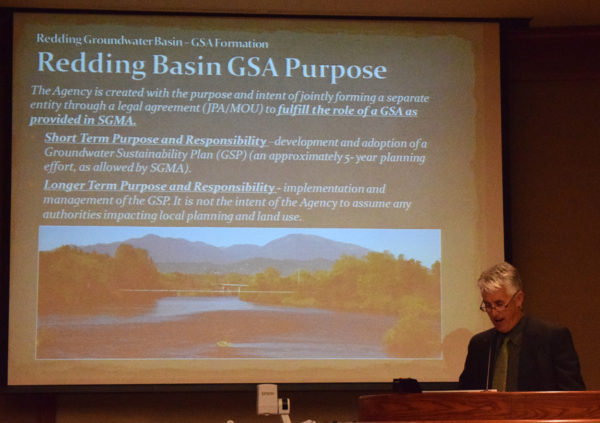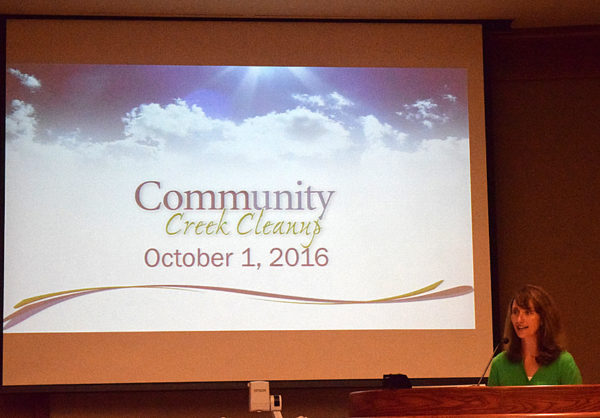Redding sits on top of a gold mine—an aquifer the size of Shasta Lake that holds an estimated 6 million acre-feet of water—and the time has come to plan for its management.
“We have a healthy basin,” Public Works Director Brian Crane said Tuesday while describing Redding’s groundwater holdings. The trick now is to get the associated stakeholders together and develop a plan that will hopefully ensure that liquid resource is carefully managed and sustained.
The state of California, with its enactment in 2014 of the Sustainable Groundwater Management Act, is insisting on that very course of action, Crane told the Redding City Council. If Redding and the other involved governments and water districts fail to establish a Groundwater Sustainability Agency (GSA) by June of next year, the state will step in and manage the north state’s groundwater.
Not only is the state’s intervention an unappealing prospect, Redding and the other government parties would have to pay for the state’s management efforts, Crane said.
Each GSA will be required to develop a Groundwater Sustainability Plan. In Redding’s case, that means a plan for the management of the Redding Groundwater Basin and the two sub-basins (Enterprise and Anderson) that have been identified by the California Department of Water Resources.
Crane said the two sub-basins are divided by the Sacramento River. The Enterprise sub-basin stretches from the Highway 299/Shasta College area south to the Churn Creek Bottom, while the Anderson sub-basin covers an area stretching from downtown Redding west to Igo and Ono and south to Cottonwood Creek.
Under terms of the state’s groundwater management act, agencies that lie on the basins are required to collaborate on a GSA. The affected agencies are the cities of Redding and Anderson, Shasta County, the Anderson-Cottonwood Irrigation District, the Bella Vista Water District and the Clear Creek Community Services District. (The Centerville, Igo-Ono and Cottonwood CSDs also are affected but they have opted to let Shasta County represent them in the GSA, Crane said.)
Progress on the GSA is moving ahead, Crane said, with a conceptual framework in place that includes a governing board and a voting structure. Presentations similar to Tuesday night’s were made to the Shasta County Board of Supervisors and will be offered to the Anderson City Council and the affected water district boards.
As proposed, Anderson, Redding and Shasta County would have two members each on the GSA while ACID, Bella Vista and Clear Creek CSD would have one each. The cost of a consultant to administer the GSA would be shared on a proportional basis, Crane said.
An effort was made to give each GSA member agency a voice commensurate with the population each agency serves. Crane said he’s fairly confident the participation levels are adequately divided since “everybody feels like a loser; no one feels like they have enough representation.”
Twin goals of each GSA member are to meet the state’s June 30, 2017, deadline and to preserve as much local control over groundwater as possible. Once established, the GSA will have five years to develop a sustainability plan.
Up next is a determination on the legal authority to govern the GSA, namely whether to establish a joint powers authority or rely on a memorandum of understanding, Crane said. An open house is scheduled from 4 to 7 p.m. Dec. 7 to gather more input on the GSA.
Mayor Missy McArthur expressed concern whether the GSA will be established by the deadline, noting “we don’t want the state to come in and manage our groundwater.” Crane said he’s been assured by the Department of Water Resources that “we’re well ahead of the rest of the state.”
In other action Tuesday, the council:
A Donald Trump message?
–Near the beginning of Tuesday’s meeting, McArthur took a moment to note that “this body up here absolutely abhors the idea of any kind of sexual predator behavior.” She noted the council addressed the topic of domestic violence at its Oct. 4 meeting, “and we want to go on record: that’s not what we want in our city. Period. So anything you’re seeing on national news is not OK with this board.”
McArthur did not elaborate but it appeared her comments were in response to recent news reports about a leaked “Access Hollywood” video from 2005 in which Republican presidential candidate Donald Trump can be heard boasting about using his celebrity status to assault women.
No more Amex or MasterCard
–Heard a report from City Treasurer Allyn Van Hooser on changes to the city’s policy on accepting credit card payments that will take effect in January. The first change concerns American Express credit cards, which will no longer be accepted due to their higher processing fees.
The second change concerns MasterCard, which will no longer be accepted for commercial utility account, due to high pass-through fees tied to business-reward cards issued to larger commercial businesses.
The treasurer said the city began noticing a spike in credit card processing fees in November 2014 and after a lengthy investigation, it was determined that the culprit was a handful of large commercial MasterCard transactions that went through a third-party processor. In those cases, the city was being charged a pass-through fee in excess of 2.5 percent, compared with fees typically in the .7 percent range.
Van Hooser said the new policy will save ratepayers about $250,000 a year.
Community Creek Cleanup
–Heard a report from Community Services Director Kim Niemer on the 2016 Community Creek Cleanup and Parke Diem projects. Some 350 volunteers, organized by John and Janet Erwin, set out on Oct. 1 to clean the bank of the Sacramento River just downstream from the North Market Street Bridge.
Niemer said 1,600 pounds of litter were removed and a whopping 180 cubic yards of non-native vegetation was fed into chippers and turned into mulch.
Parke Diem was held the following weekend and volunteers worked on the Benton Dog Park and Mary Lake Park.




